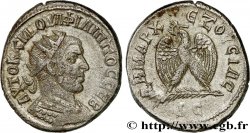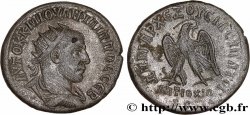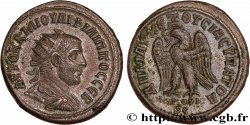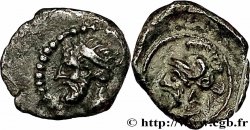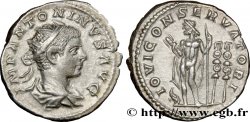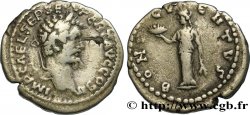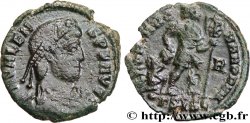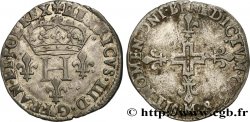bpv_153780 - PHILIPPUS I. ARABS Tétradrachme syro-phénicien
Nicht verfügbar.
Artikel auf unserem Online-Shop verkauft (2015)
Preis : 85.00 €
Artikel auf unserem Online-Shop verkauft (2015)
Preis : 85.00 €
Type : Tétradrachme syro-phénicien
Datum: 244
Name der Münzstätte / Stadt : Antioche, Syrie, Séleucie et Piérie
Metall : Scheidemünze
Durchmesser : 28,00 mm
Stempelstellung : 12 h.
Gewicht : 14,02 g.
Kommentare zum Erhaltungszustand:
Frappe, coins et centrage parfaits, mais marques de corrosion au droit et au revers
N° im Nachschlagewerk :
Pedigree :
Cet exemplaire est le 0304A_033
Vorderseite
Beschreibung Vorderseite Buste lauré, drapé et cuirassé de Philippe Ier à droite, vu de trois quarts en arrière (A*2).
Legende des Averses AUTOK K M IOUL FILIPPOU SEB, (Autokratoros Kaisaros Markos Ioulios Filippos Sebastos)
Übersetzung der Vorderseite (L’empereur césar Marc Jules Philippe auguste).
Rückseite
Titulatur der Rückseite S|C// MON VRB À L’EXERGUE.
Beschreibung Rückseite Aigle debout à droite, les ailes déployées, tête et queue à gauche, tenant une couronne feuillée dans son bec, sans ligne de terre.
Legende des Reverses : DHMARC - EX OUSIAS, (Dhmarcikhs Ex Ousias)
Übersetzung der Rückseite (Revêtu de la puissance tribunitienne/ Monnaie de la Ville / avec l’accord du Sénat).
Kommentare
Depuis la publication du Prieur, le type 304, premier pour Philippe l’arabe, a été divisé en deux parties : avec ou sans ligne de terre au revers sous l’aigle. En effet, les frappes avec marques d’officines sont pratiquement toutes sans ligne de terre (une très rare exception à l’officine Gamma), alors que celles sans marque d’officine se partagent à 70 (avec ligne de terre) / 30 (sans ligne de terre).
On peut donc supposer que l’émission commence par une frappe importante sans marque d’officine et avec ligne de terre, suivie d’une frappe moins importante toujours sans marque d’officine mais sans ligne de terre, pour se terminer par une frappe avec marques d’officine et sans ligne de terre.
La question du lieu de frappe, au sens de fabrication et non de mise en circulation, a été tranchée par H. R. Baldus, Moneta Urbis - Antioxia, Francfort 1969, et il semble bien que ces monnaies ont été fabriquées à Rome, plutôt qu’à Antioche.
Le raisonnement de H.R. Baldus concernant cette émission de Philippe repose avant tout sur la signature de l’atelier au revers : dans le monde romain, l’Urbs, la Ville, ne peut être que Rome. Le cas n’est pas isolé et il a été déterminé, par exemple, que des tétradrachmes d’Alexandrie pour Sévère Alexandre avaient été frappés à Rome puis envoyés en Égypte ; on peut penser que des questions de prix de revient et de qualité de fabrication furent à l’origine de ces migrations.
Effectivement, les portraits de cette émission sont exceptionnellement bons, équivalents aux meilleurs sesterces de l’atelier de Rome.
Autre particularité de cette émission, le retour du SC, disparu des revers entre 242 et 244, après avoir remplacé à Antioche le Delta Eta apparu en 215, et jamais vu dans un autre atelier officiel. Si nous suivons la logique développée pour ces émissions, il faut croire que ces frappes de Philippe ont reçu l’assentiment (au moins) et le financement (au plus) du sénat d’Antioche. Une gigantesque rançon ayant été payée aux Perses pour abréger la guerre, le propre frère de Philippe étant gouverneur de Syrie, sa propre famille en étant originaire, on peut au moins penser que le Sénat regagna de son importance de l’époque des Sévères. La réputation de Priscus étant de pressurer la population - au point de susciter l’usurpateur Jotapian - on peut aussi penser que le produit de ces spoliations servit à frapper des tétradrachmes au portrait et donc à la gloire de l’Empereur.
On note que les sigma sont gravés en C.
Dans la base TSP maintenue par Michel Prieur, cinquante-cinq exemplaires sont maintenant répertoriés pour le type sans ligne de terre seul dont en musées Berlin (3), British Museum, Paris (2), Princeton, ANS (2) et Oxford.
Since the publication of the Prior, type 304, the first for Philip the Arab, has been divided into two parts: with or without a ground line on the reverse under the eagle. In fact, the strikes with pharmacy marks are practically all without ground line (a very rare exception at the Gamma pharmacy), while those without pharmacy mark are divided at 70 (with ground line) / 30 (without ground line).
We can therefore assume that the issue begins with a significant strike without an office mark and with a ground line, followed by a less significant strike, still without an office mark but without a ground line, to end with a strike with office marks and without a ground line..
The question of the place of minting, in the sense of manufacture and not of putting into circulation, was decided by H. R. Baldus, Moneta Urbis - Antioxia, Frankfurt 1969, and it seems that these coins were made in Rome, rather than in Antioch.
H's reasoning. R. Baldus's opinion on this issue of Philip rests above all on the workshop signature on the reverse: in the Roman world, the Urbs, the City, can only be Rome.. This is not an isolated case and it has been determined, for example, that Alexandrian tetradrachms for Severus Alexander were minted in Rome and then sent to Egypt; it is possible to assume that questions of cost price and manufacturing quality were at the origin of these migrations..
Indeed, the portraits in this issue are exceptionally good, equivalent to the best sesterces from the Roman workshop..
Another particularity of this issue is the return of the SC, which disappeared from the reverses between 242 and 244, after having replaced the Delta Eta in Antioch, which appeared in 215, and never seen in another official mint.. If we follow the logic developed for these emissions, we must believe that these strikes of Philip received the assent (at least) and the financing (at most) of the senate of Antioch. A gigantic ransom having been paid to the Persians to shorten the war, Philip's own brother being governor of Syria, his own family being from there, one can at least think that the Senate regained its importance of the time of the Severans. Priscus's reputation for squeezing the population - to the point of giving rise to the usurper Jotapian - we can also think that the product of these spoliations was used to strike tetradrachms with the portrait and therefore to the glory of the Emperor..
Note that the sigmas are engraved in C.
In the TSP database maintained by Michel Prieur, fifty-five examples are now listed for the type without ground line alone, including in museums Berlin (3), British Museum, Paris (2), Princeton, ANS (2) and Oxford
On peut donc supposer que l’émission commence par une frappe importante sans marque d’officine et avec ligne de terre, suivie d’une frappe moins importante toujours sans marque d’officine mais sans ligne de terre, pour se terminer par une frappe avec marques d’officine et sans ligne de terre.
La question du lieu de frappe, au sens de fabrication et non de mise en circulation, a été tranchée par H. R. Baldus, Moneta Urbis - Antioxia, Francfort 1969, et il semble bien que ces monnaies ont été fabriquées à Rome, plutôt qu’à Antioche.
Le raisonnement de H.R. Baldus concernant cette émission de Philippe repose avant tout sur la signature de l’atelier au revers : dans le monde romain, l’Urbs, la Ville, ne peut être que Rome. Le cas n’est pas isolé et il a été déterminé, par exemple, que des tétradrachmes d’Alexandrie pour Sévère Alexandre avaient été frappés à Rome puis envoyés en Égypte ; on peut penser que des questions de prix de revient et de qualité de fabrication furent à l’origine de ces migrations.
Effectivement, les portraits de cette émission sont exceptionnellement bons, équivalents aux meilleurs sesterces de l’atelier de Rome.
Autre particularité de cette émission, le retour du SC, disparu des revers entre 242 et 244, après avoir remplacé à Antioche le Delta Eta apparu en 215, et jamais vu dans un autre atelier officiel. Si nous suivons la logique développée pour ces émissions, il faut croire que ces frappes de Philippe ont reçu l’assentiment (au moins) et le financement (au plus) du sénat d’Antioche. Une gigantesque rançon ayant été payée aux Perses pour abréger la guerre, le propre frère de Philippe étant gouverneur de Syrie, sa propre famille en étant originaire, on peut au moins penser que le Sénat regagna de son importance de l’époque des Sévères. La réputation de Priscus étant de pressurer la population - au point de susciter l’usurpateur Jotapian - on peut aussi penser que le produit de ces spoliations servit à frapper des tétradrachmes au portrait et donc à la gloire de l’Empereur.
On note que les sigma sont gravés en C.
Dans la base TSP maintenue par Michel Prieur, cinquante-cinq exemplaires sont maintenant répertoriés pour le type sans ligne de terre seul dont en musées Berlin (3), British Museum, Paris (2), Princeton, ANS (2) et Oxford.
Since the publication of the Prior, type 304, the first for Philip the Arab, has been divided into two parts: with or without a ground line on the reverse under the eagle. In fact, the strikes with pharmacy marks are practically all without ground line (a very rare exception at the Gamma pharmacy), while those without pharmacy mark are divided at 70 (with ground line) / 30 (without ground line).
We can therefore assume that the issue begins with a significant strike without an office mark and with a ground line, followed by a less significant strike, still without an office mark but without a ground line, to end with a strike with office marks and without a ground line..
The question of the place of minting, in the sense of manufacture and not of putting into circulation, was decided by H. R. Baldus, Moneta Urbis - Antioxia, Frankfurt 1969, and it seems that these coins were made in Rome, rather than in Antioch.
H's reasoning. R. Baldus's opinion on this issue of Philip rests above all on the workshop signature on the reverse: in the Roman world, the Urbs, the City, can only be Rome.. This is not an isolated case and it has been determined, for example, that Alexandrian tetradrachms for Severus Alexander were minted in Rome and then sent to Egypt; it is possible to assume that questions of cost price and manufacturing quality were at the origin of these migrations..
Indeed, the portraits in this issue are exceptionally good, equivalent to the best sesterces from the Roman workshop..
Another particularity of this issue is the return of the SC, which disappeared from the reverses between 242 and 244, after having replaced the Delta Eta in Antioch, which appeared in 215, and never seen in another official mint.. If we follow the logic developed for these emissions, we must believe that these strikes of Philip received the assent (at least) and the financing (at most) of the senate of Antioch. A gigantic ransom having been paid to the Persians to shorten the war, Philip's own brother being governor of Syria, his own family being from there, one can at least think that the Senate regained its importance of the time of the Severans. Priscus's reputation for squeezing the population - to the point of giving rise to the usurper Jotapian - we can also think that the product of these spoliations was used to strike tetradrachms with the portrait and therefore to the glory of the Emperor..
Note that the sigmas are engraved in C.
In the TSP database maintained by Michel Prieur, fifty-five examples are now listed for the type without ground line alone, including in museums Berlin (3), British Museum, Paris (2), Princeton, ANS (2) and Oxford







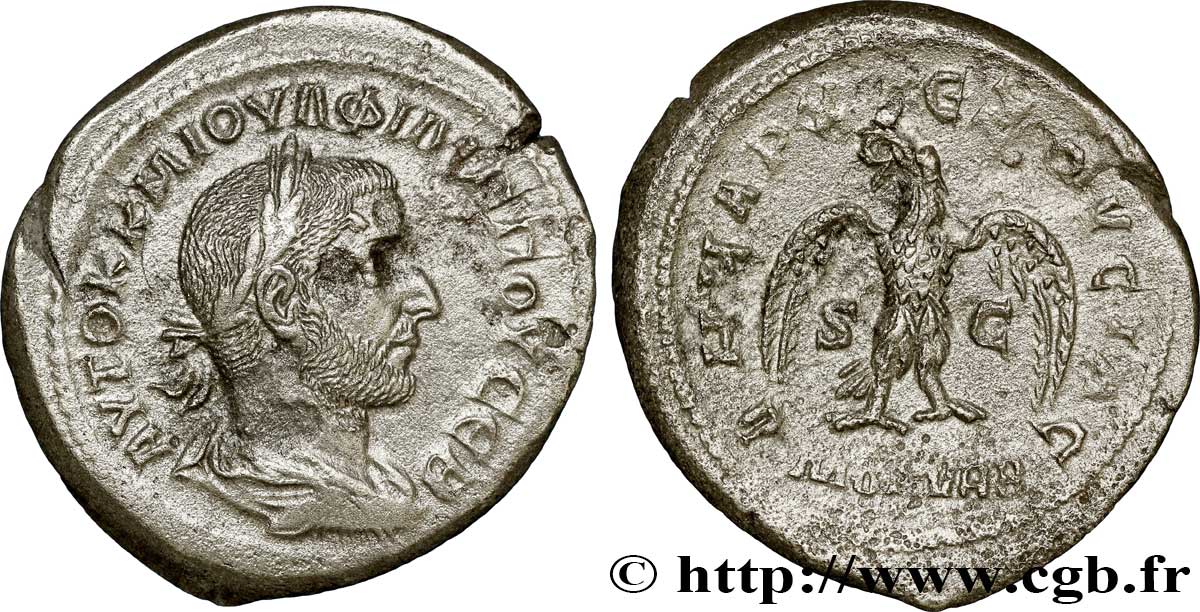
 Berichten über einen Fehler
Berichten über einen Fehler Die Seite drucken
Die Seite drucken Teilen meiner Auswahl
Teilen meiner Auswahl Stellen Sie eine Frage
Stellen Sie eine Frage Einlieferung/Verkauf
Einlieferung/Verkauf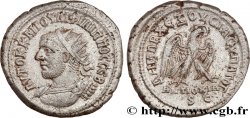
 Details
Details